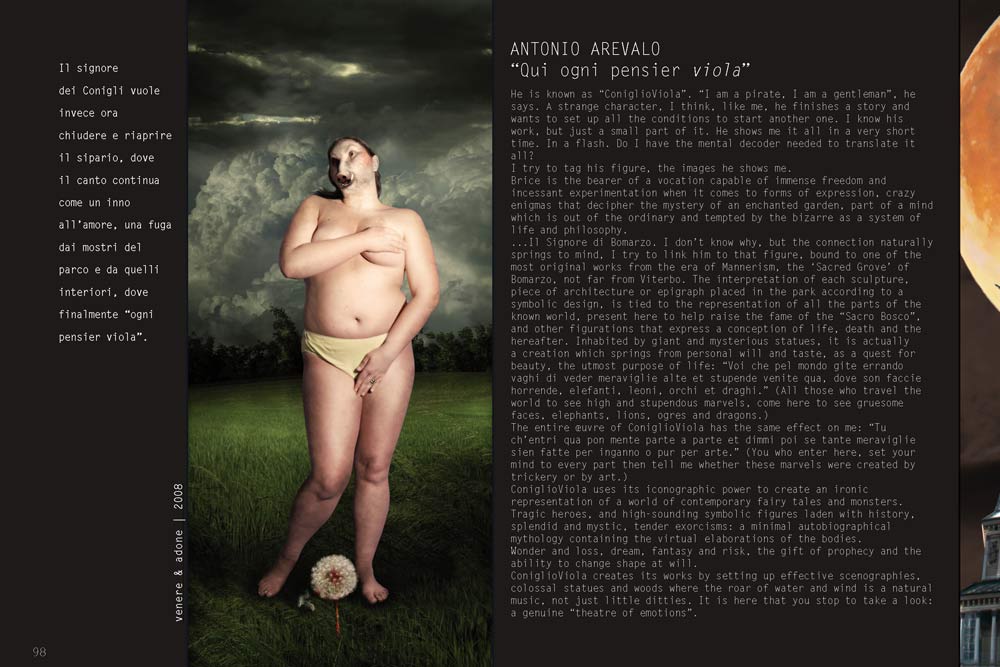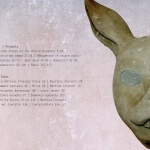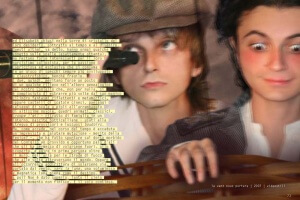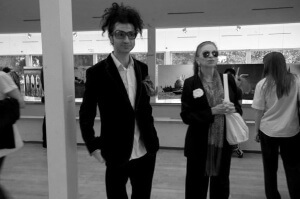Antonio Arevalo – Here every thought flies
He is known as “ConiglioViola”. “I am a pirate, I am a gentleman”, he says. A strange character, I think, like me, he finishes a story and wants to set up all the conditions to start another one. I know his work, but just a small part of it. He shows me it all in a very short time. In a flash. Do I have the mental decoder needed to translate it all? I try to tag his figure, the images he shows me. Brice is the bearer of a vocation capable of immense freedom and incessant experimentation when it comes to forms of expression, crazy enigmas that decipher the mystery of an enchanted garden, part of a mind which is out of the ordinary and tempted by the bizarre as a system of life and philosophy. …Il Signore di Bomarzo. I don’t know why, but the connection naturally springs to mind, I try to link him to that figure, bound to one of the most original works from the era of Mannerism, the ‘Sacred Grove’ of Bomarzo, not far from Viterbo. The interpretation of each sculpture, piece of architecture or epigraph placed in the park according to a symbolic design, is tied to the representation of all the parts of the known world, present here to help raise the fame of the “Sacro Bosco”, and other figurations that express a conception of life, death and the hereafter. Inhabited by giant and mysterious statues, it is actually a creation which springs from personal will and taste, as a quest for beauty, the utmost purpose of life: “Voi che pel mondo gite errando vaghi di veder meraviglie alte et stupende venite qua, dove son faccie horrende, elefanti, leoni, orchi et draghi.” (All those who travel the world to see high and stupendous marvels, come here to see gruesome faces, elephants, lions, ogres and dragons.) The entire oeuvre of ConiglioViola has the same effect on me: “Tu ch’entri qua pon mente parte a parte et dimmi poi se tante meraviglie sien fatte per inganno o pur per arte.” (You who enter here, set your mind to every part then tell me whether these marvels were created by trickery or by art.) ConiglioViola uses its iconographic power to create an ironic representation of a world of contemporary fairy tales and monsters. Tragic heroes, and high-sounding symbolic figures laden with history, splendid and mystic, tender exorcisms: a minimal autobiographical mythology containing the virtual elaborations of the bodies. Wonder and loss, dream, fantasy and risk, the gift of prophecy and the ability to change shape at will. ConiglioViola creates its works by setting up effective scenographies, colossal statues and woods where the roar of water and wind is a natural music, not just little ditties. It is here that you stop to take a look: a genuine “theatre of emotions”.
In Bomarzo, in soft light, when the season explodes in the brightest of greens, the stone creatures appear without a past, timeless, almost as if challenging the torment of routine. A giant in the act of dismembering his unfortunate victim. An elephant picking up a soldier. An enormous tortoise bearing the tiny figure of a woman standing on a ball. A surreal, bizarre population of terrifying beasts, giants, pagan divinities, bears and dragons. A riotous fantasy that knows no rules. The Ogre’s wide open mouth and empty eye sockets hide the bitter sentence “qui ogni pensier vola” (here every thought flies), and a room with chairs and a table carved out of stone. There is nothing monstrous apart from the distorted proportions, outlandish digressions and wild fantasies to sedate the urgency of the expression. Along the path, frightening visions alternate with the attractive sight of nymphs and sirens with extraordinarily beautiful faces. With this classically-composed, romantic construction, Vicino Orsini, signore di Bomarzo, paid homage to the memory of his wife Giulia.
The Coniglio, on the other hand now want to bring down then reopen the curtain, where the singing continues like a anthem to love, fleeing from the monsters in the park and from our inner demons, where, at last “ogni pensier viola”.
Antonio Arevalo


 Next Post
Next Post


